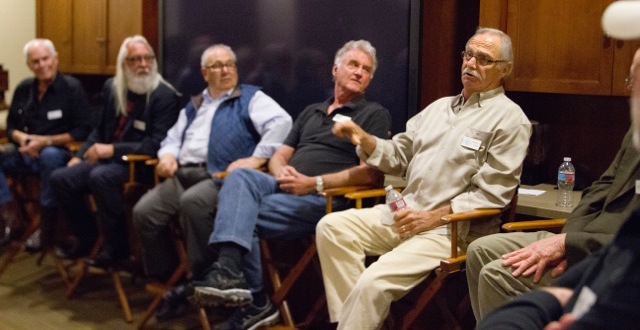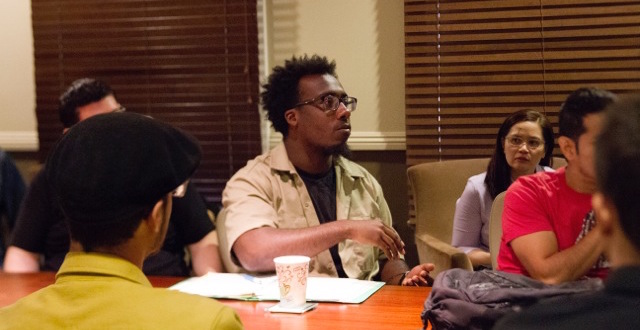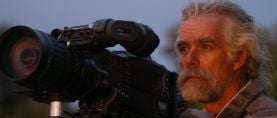
ASC Panel Imparts Wisdom

During an Educational Outreach event held on March 10, George Spiro Dibie ASC, chair of the Society’s Education & Outreach Committee, presided over a panel of prestigious ASC cinematographers as they answered questions posed by students, some of whom were visiting from New York City’s School of Visual Arts and, closer to home, California State University Northridge.
In an event staged at the ASC Clubhouse in Hollywood, Dibie described the Society’s origins. “The ASC is 97 years old,” he said. “In 1919, a small group of cinematographers rented a room in Hollywood and came together after a day of shooting to talk about their work. They asked questions then and that’s what we’re still doing now — asking questions.”
On hand to answer those questions were ASC members Bill Bennett, Mark Irwin, Charlie Lieberman, Don McCuaig, Chuck Minsky, Michael O’Shea, Steven Shaw, Rodney Taylor and Kenneth Zunder.
Noting that the cinematographers work in TV and film, one student asked how they collaborate with the director to achieve their vision in both media. O’Shea answered that on a TV series, the cinematographer establishes a look with the producer. “You always try to stay with the look the producer wants,” he said. “Some directors have a different idea, but you have to guide [them] toward what the producer wants.” Lieberman shared an example, recounting that when a director and the showrunner’s favorite cinematographer clashed on a TV episode, the showrunner fired the director.

“We’re creating art with a stopwatch, and the showrunner is a representative of the money,” said Irwin. “We’re in charge of a whole fleet of people to make that day. If the director wants to make his day, he’ll make it with us. I call it creativity with a gun to your head.”
Zunder pointed out that it’s important for cinematographers to understand editing. “The most important question is when they’ll use the shot,” he said. “Very often they’ll shoot things that don’t make it into the cut. If we know how the show cuts together, we can guide them better.” McCuaig agreed, adding that cinematographers should learn to edit as well as composite and do other post-related tasks. “Before, we spent a lot of time closely lighting things,” he said. “Now we do it in post. You must learn the apps and how they apply; otherwise, somebody will tell you how to do your job.”
Other cinematographers spoke about how they worked with directors to collaborate on a look. “I had several directors who were very visual,” said Shaw. “On one shoot in Amsterdam, we went straight to the museum [to look] at the Vermeers and he said, ‘That’s what I want my movie to look like.’”
Another student asked how much information the cinematographers give to their gaffers. “It’s important to hire the most experienced people you can find and afford,” said Bennett. “If you tell them how you want it to look and not how to do it, they’re creatively invested and that pays off. It’s important for them to have your back.” Dibie noted that because he came from lighting, he would tell the gaffer which light to use and where to put it. On the other hand, Taylor reported that he came up through the camera-department side, and thus relies a bit more on input from his lighting crew. “I prefer to have people collaborating with me,” he said. “I try to keep them in the game and involved.”
McCuaig told the students they shouldn’t be intimidated by a gaffer. “Don’t let a teamster, key grip or gaffer do that,” he said. “Always use your common sense and rig the way you’re going.” Minsky offered, “When you start working with the gaffer, you’ll find out [whether you need to give directions]. When you work with someone for a long time, they’ll know what you like and hate, and it’ll be a lot easier.”
One student asked why anyone would want to shoot on film. Opening a copy of American Cinematographer, Dibie read a list of films shot this past year on celluloid. “Find out who directed these titles,” he suggested. Taylor said he still prefers film. “On TV, that ship has sailed,” he said. “You’re going to shoot digital. For feature films, I still like to read the script and determine if it’s film or digital. For me, it’s still about the story. But digital has big advantages now, especially for night shooting.”
Irwin noted one of the biggest changes with shooting digitally. “I worked with Wes Craven and David Cronenberg, who knew they had to shoot 6,000 feet,” he said. “That created a discipline. The way it is now, the director says, ‘Let’s keep shooting — there’s a story in there somewhere.’ Do you have enough discipline to shoot one SxS card? I don’t think so. I like to joke with directors that there was a famous director who worked without a video tap or a Technocrane, and he only had one eye: John Ford, who won four Oscars.”
Lieberman noted that film and digital are tools, “and each has their positives and negatives. As you evolve in the business and get respect for your work, you may be able to influence the decision of whether to shoot film or digital. But you won’t have that [clout] in the beginning.”
One student asked how the cinematographers choose lenses. “Not by focal length,” he said, noting that the decision is more based on whether the lenses are “anamorphic, spherical, Cookes or Zeiss.”
“That’s a great question,” added Taylor. “I find the cameras pretty much the same. The lens is the choice to tell the story. We used to use film stock to tell a story, and now lenses are a great way to help you.” Bennett noted that camera rental houses let cinematographers shoot tests. “The beauty of digital is you can see it all that evening on a larger screen or your laptop,” he said. He also gave a tip: put the slate in the shot all the time. “Otherwise, if you do split-screen comparisons, you’ll have to rewind to find out what you used, and that gets tiresome.”
Several cinematographers reported on the trend of using older lenses. “As camera manufacturers are pushing cameras of higher and higher resolution, you’ll find cinematographers across the board using older and older lenses,” Bennett said, noting that a set of vintage Super Baltar lenses from the 1930s costs more than $70,000. “What film had was this organic sense,” he continued. “What many of us miss to this day is the lack of that organic [feel,] and when you use older lenses like the Baltars, that organic quality comes back, almost in spite of the 4K/6K camera.” Minsky agreed, noting his preference for old Primos from the 1970s. “The lenses are getting so sharp and brittle, [which] doesn’t [help to] tell the story [emotionally,]” he added.
Monitors are ubiquitous on set, noted one student, who asked if he should he light by the monitor or by eye. “Light by eye,” said Zunder. “But you have to know how the camera will see [the scene,] which is sometimes differently than your eyes in terms of shadows and highlights. But you can’t light remotely. You have to be on the set.” Bennett added, “If you don’t keep referring back to the monitor, you will overlight the set.” Dibie stressed, “You have to make sure your monitors are set up correctly. Let the DIT set it up every day.”
The topic of the digital intermediate arose when one student asked about the difference between a film and digital projection. Bennett explained, “The one advantage to a digital intermediate is that when you shoot film and get a chemical or optical print back out to film, you’re very limited in the dynamic range. But if you do a scan, you can see farther into the highlights and shadows and put that into the print. Film only obtained its 15 to 16 stops of dynamic range through a DI.”
All the students were interested in the answer to a final question: What are the financial hurdles in pursuing a career as a cinematographer? Dibie, as former president of the Camera Guild, noted that it’s still difficult to get into the union. “Get a job on a non-union shoot,” he advised. “Then you’ll get organized, and once you’re organized, the union will take you in.” All the cinematographers agreed on one piece of wisdom: save your money. “Don’t be afraid to take unrelated jobs,” said Zunder. “Being on the set in any capacity is better than not being there. Everyone in Hollywood can be divided into two categories: those who are working and those who wish they were working. Say yes to everything.”
“It’s not an easy career,” said Minsky. “We’ve all worked out way up. Take whatever job comes your way and learn how to shoot. There is no easy, right way.”
Irwin concluded that making mistakes is a great experience, especially for students. “You have to reflect on the unique position you are in as film students,” he said. “You get to make mistakes and learn from them. It’s different if you’re learning on the job and make mistakes. Go the distance and beyond. We all make mistakes, and some of us were fired because of it. But it’s redemption to make mistakes and learn, and it’s a crucible you should share together.”






